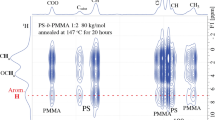Abstract
The study of the T2 relaxation of nuclear spins, using a pulsed NMR sequence, can provide information on many aspects of molecular weight and mobility, morphology, crosslinking, entanglements, as well as on the influence of temperature and of solvents. This relatively new technique of analysis, based largely on irradiated polymers of known arrangements can also be extended to biopolymers, and determine for example the influence of additives, of radiation or chemical rearrangement, on the configuration and mobility of these macromolecules. The method of T2 relaxation by spin-spin interaction is quite distinct from the very widely utilised T1 spin-lattice interaction which depends primarily on local environment, suitable for the determination of chemical structure. The T2 pulsed technique is particularly appropriate to analyse complex systems, as for example partially crystalline specimen, network-non network composites, molecular rearrangements occurring during melting or crystallization oriented and reinforced polymers dissolved or entangled high molecular weight chain molecules. Many of the data provided by this techniques can now be understood, but in some systems, basic work still remains to be done to elucidate the meaning of the information which it provides.
Similar content being viewed by others
References
S. R. AHMAD, A. CHARLESBY, Radiat. Phys. Chem., 8 (1976) 497.
S. R. AHMAD, A. CHARLESBY, Radiat. Phys. Chem., 8 (1976) 585.
R. FOLLAND, A. CHARLESBY, Radiat. Phys. Chem., 8 (1976) 555.
A. CHARLESBY, J. H. STEVEN, Radiat. Phys. Chem., 8 (1976) 719.
A. CHARLESBY, R. FOLLAND, Tihany 4th Symp. Rad. Chem., Akadémiai Kiadó, Budapest, 1976, p. 335.
R. FOLLAND, A. CHARLESBY, Radiat. Phys. Chem., 10 (1977) 61.
A. CHARLESBY, R. FOLLAND, J. H. STEVEN, Proc. Roy Soc., A 355 (1977) 189.
R. FOLLAND, A. CHARLESBY, J. Polymer Sci. Polymer Letters, 16 (1978) 339.
A. CHARLESBY, P. KAFER, R. FOLAND, Radiat. Phys. Chem., 11 (1978) 83.
R. FOLLAND, J. H. STEVEN, A. CHARLESBY, J. Polymer. Sci., Pub. Phys. Ed., 16 (1978) 1041.
R. FOLLAND, A. CHARLESBY, Polymer, 20 (1979) 207.
R. FOLLAND, A. CHARLESBY, Polymer, 20 (1979) 211.
A. CHARLESBY, Radiat. Phys. Chem., 14 (1979) 919.
A. CHARLESBY, R. FOLLAND, Radiation Research Conf., Tokyo, 1979, p. 336.
B. J. BRIDGES, A. CHARLESBY, R. FOLLAND, Proc. Roy. Soc. London, A 367 (1979) 343.
A. CHARLESBY, R. FOLLAND, Radiat. Phys. Chem., 15 (1980) 393.
I. KAMEL, A. CHARLESBY, J. Polymer Sci., 19 (1981) 803.
A. CHARLESBY, B. J. BRIDGES, Eur. Polymer J., 17 (1981) 645.
A. CHARLESBY, B. J. BRIDGES, Radiat. Phys. Chem., 19 (1982) 155.
A. CHARLESBY, Tihany 5th Symp. Rad. Chem., Akadémiai Kiadó, Budapest, 1982, p. 843.
A. CHARLESBY, B. M. JAROSZKIEWICZ, Eur. Polymer J., 21 (1985) 55.
Author information
Authors and Affiliations
Rights and permissions
About this article
Cite this article
Charlesby, A. The use of pulsed NMR to determine morphology of macromolecules. Journal of Radioanalytical and Nuclear Chemistry, Articles 101, 401–411 (1986). https://doi.org/10.1007/BF02042442
Received:
Issue Date:
DOI: https://doi.org/10.1007/BF02042442




